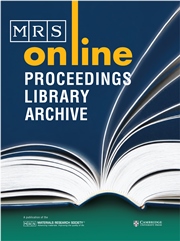Article contents
Real-Time Monitoring of Indium Tin Oxide Laser Ablation in Liquid Crystal Display Patterning
Published online by Cambridge University Press: 15 February 2011
Abstract
Audible acoustic wave detection is applied to investigate KrF excimer laser ablation of Indium Tin Oxide (ITO) thin film layer for Liquid Crystal Display (LCD) patterning. It is found that there is no acoustic wave generation if laser fluence is lower than ITO ablation threshold. For laser fluence higher than the threshold, audible acoustic wave will be detected due to shock wave generation during ITO laser ablation. The amplitude of the acoustic wave is closely related to the laser ablation rate. With more laser pulse applied, the amplitude is dropped to zero because the ITO layer is completely removed. However, if laser fluence is increased higher than ablation threshold for glass substrate, the amplitude is also dropped with pulse number but not to zero. It is due to laser ablation of ITO layer and glass substrate at the same time. Since the thickness of ITO layer is in a scale of 100 nm, laser interaction with glass substrate will happen even at the first pulse of high laser fluence irradiation. Laser ablation induced ITO plasma emission spectrum in visible light region is analyzed by an Optical Multi-channel Analyzer (OMA). Specific spectral lines are In I (325.8, 410.2 and 451.1 nm) and In II 591.1 nm. Spectral intensities of 410.2 and 451.1 nm lines are selected to characterize the evolution of ITO plasma intensity with laser fluence and pulse number. It is found that the spectral intensities are reduced to zero with laser pulse number. It is also found that spectral lines other than ITO plasma will appear for laser fluence higher than ablation threshold for glass substrate. Threshold fluences for glass and ITO ablation are estimated for setting up a parameter window to control LCD patterning in real-time.
- Type
- Research Article
- Information
- Copyright
- Copyright © Materials Research Society 1998
References
- 1
- Cited by


